Man of Steel has its US theatre release today. It claims to be a fresh look at Superman as well as an origin story of sorts. In honor of this, today I’m looking at a Superman origin story from the comics. Eric talked about Superman: Birthright a couple of months ago, so I’m going to take a look at Superman For All Seasons, a retelling of Superman’s origin that was published in 1998.
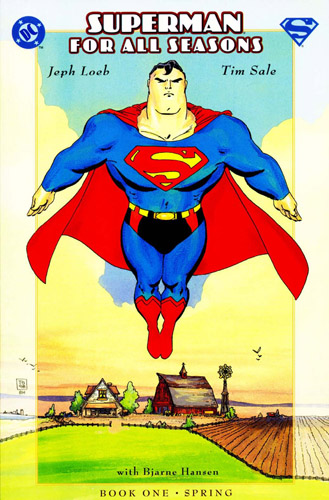
The interesting thing about this take on Superman’s origin is that it’s told through the eyes of the people around him. Each of the four books is named after a season, and each season is told from a different person’s perspective. It’s a fresh take on the idea of an origin, and it gives a lot of really diverse perspectives on the tale that we’re all familiar with.
We start in the spring before Clark’s graduation from high school in Smallville, with Pa Kent as our narrator. He gives a flyby account of how he and Ma ended up raising Clark, giving us a two-page summary of the “found a baby in a rocket, kept him, and now here we are” story.
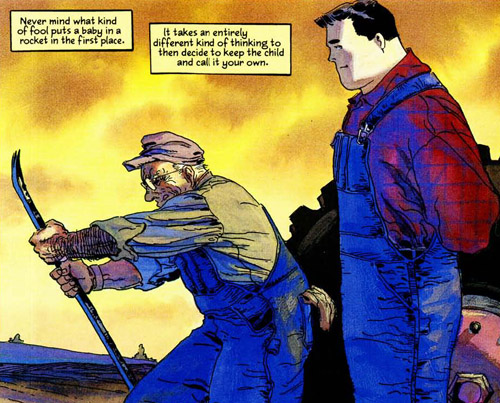
For the most part, Clark is a regular Smallville kid, helping his parents run their farm and hanging out at the general store with his best friends, Pete Ross and Lana Lang. It contrasts sharply with his abilities, which clearly worries Pa. He wants a normal life for his son, but he knows that Clark isn’t normal by Earth standards.
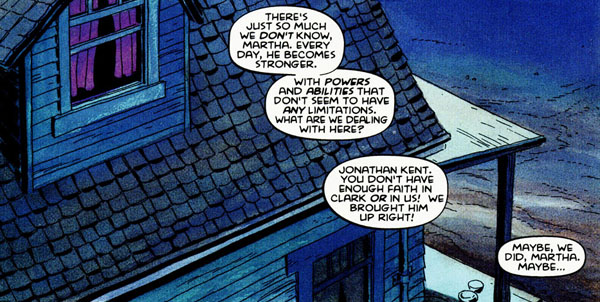
Despite his abilities, Clark fits in perfectly with his friends. Nobody suspects that he’s anything other than Jonathan and Martha’s boy, because that’s how he presents himself to the world. It’s insinuated that he hadn’t known about his past until recently, which probably has a lot to do with it; it’s not hard to act like a human if that’s what you’ve always believed yourself to be. The first time that Clark has a real problem with his cover is when he goes to get a haircut.
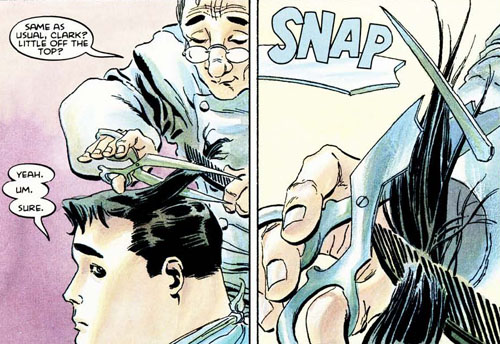
Pa talks to Clark about the incident, relating to the readers that though he tries his hardest to see Clark as a normal kid, he knows that Clark needs more than Smallville can give him.
Shortly thereafter, a tornado rips through Smallville. Pa and Ma go into the storm cellar at the farm, but Clark sees that one of the regulars at the general store is in danger, and flies in to save him. The man is unharmed, but a lot of the town is destroyed, and when Clark tells his parents what happened in town, we get one of the most important lines in the story.
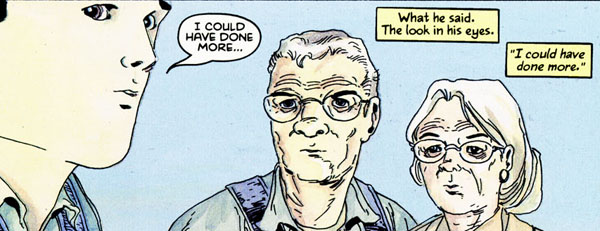
Clark graduates high school and, later that night, reveals his secret to Lana, who seems troubled but doesn’t say much. He soon decides that he has to move to Metropolis so he can figure out how to save people. He starts working at the Daily Planet, and he flies around at night, wearing his uniform and doing what he can.
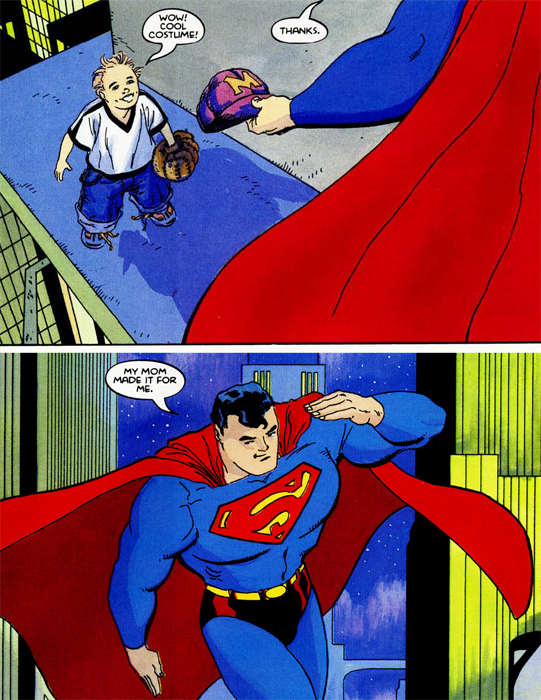
Lois Lane narrates the summer portion of the story. Superman is established at this point, and Lois tells the readers that she was the one to name him, and how even though she’s seen him do amazing things with her own eyes, she still can’t really believe that he’s real.
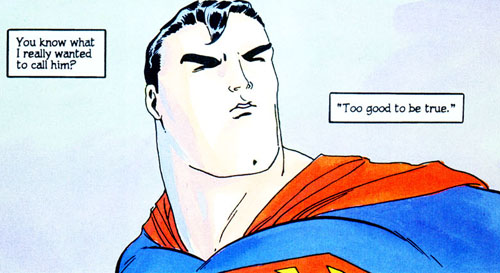
If Superman can do anything, Lois wonders, why does he choose to be a hero? Her job as a reporter gives her an interesting perspective; she writes about the worst of the worst on an everyday basis, and that’s what she’s gotten used to. Superman is the opposite of those expectations, so he intrigues her. She compares him to Santa Claus, and then to Prince Charming – both people that she believed in as a child, but has long since given up.
We get all of this as a backdrop to Lois arriving at the scene of Superman’s latest daring feat: he’s pulled a submarine that was headed to destroy Metropolis out of the water and landed it at Metropolis Air Base. Lex Luthor is there as well, and we see that they don’t get along – Luthor yells at Superman for wasting taxpayer money on cleanup for the sub being dropped at the air base, and Superman accuses Luthor of being involved in the plot he’s just stopped.
One of the terrorists catches Lois and puts a gun to her head as Superman and Luthor are fighting; Luthor tries to negotiate for her freedom, but before he can even start, Superman grabs the gun and crushes it. Lois then knocks the guy out with some very efficient martial arts.
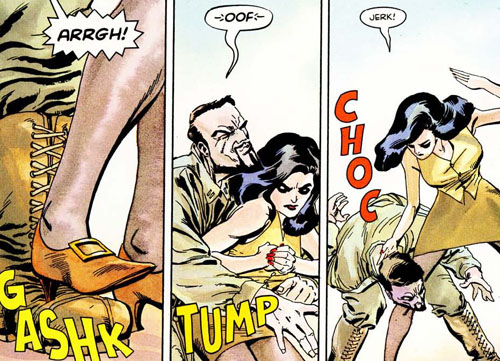
Lois opts to get a ride back to the Daily Planet with Superman instead of with Luthor, and warns Superman that nobody speaks to Luthor the way he does. He pretty much shrugs it off, and Lois goes inside, meeting up with none other than Clark Kent.
Lois wonders aloud to the reader about Superman. He’s clearly too good to be true, and there are so many questions that nobody knows the answers to – for instance, what does he do on his days off? Her musings are shown against panels of Clark sitting alone in his apartment, then visiting his parents in Smallville. Lois goes on to wonder if he has a girlfriend, and we see Clark approaching the house that Lana grew up in. He finds out that Lana left Smallville right after he did, and that nobody really knows where she is.
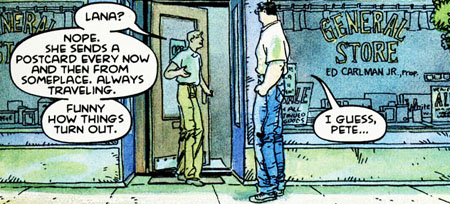
Later on, Clark admits to Ma that he feels lonely and out of place in the city, and that he expected that returning to Smallville would help, but it hasn’t. Ma assures him that it’s all part of growing up, and that things will work out for him.
Back in Metropolis, Lois is at the site of a building fire at a chemical lab. Luthor’s Guardians of the City (which are essentially robotic Superman replacements) come in to stop the fire, but they’re not enough; Superman shows up, though, and saves a scientist from the building that the Guardians had declared empty before putting out the fire by himself.
Once again, Superman shows Luthor up in his own city, and once again, Luthor doesn’t take kindly to it. We end the second chapter with Luthor approaching the scientist, Jenny Vaughn, telling her that she can help the man who saved her become the greatest hero of all time… if she goes to work for Luthor.
We switch to Lex Luthor’s perspective in the fall. He sees his life as a love story between himself and the city of Metropolis, and views Superman as the man who has stolen her love away from him.
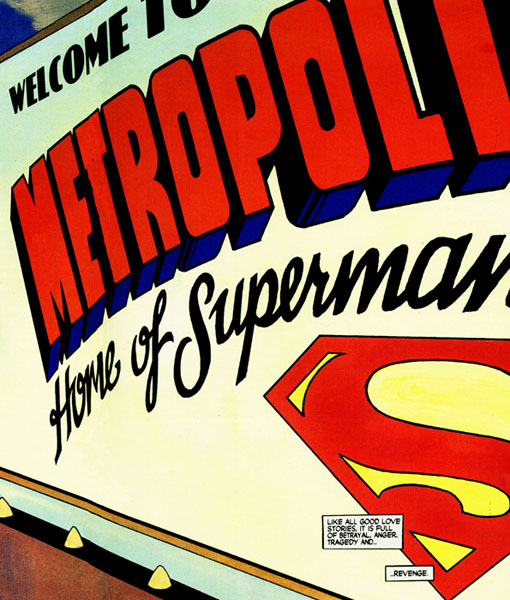
At the beginning of the chapter, Luthor is being released from jail after Superman got him arrested for an unspecified crime. We witness a conversation between Lois and her photographer wherein Lois remarks that Superman may have made a mistake in humiliating Luthor; his narration confirms that he’s planning to get revenge on Superman.
Luthor goes to visit Jenny Vaughn; we see that she’s being held captive, and is also losing her grip on sanity. She’s being forced to stare at a mural of Superman saving her, and she doesn’t say a word as Luthor talks to her, telling her that she’ll soon be in a world where Superman needs her help. She smiles dreamily, and Luthor leaves.
We soon figure out that Luthor’s plan is to poison the entire city of Metropolis. Superman is unaffected, as the poison is tailored to human biology, but everyone else that he comes across is dying. He ends up flying to Luthor’s tower, where Luthor tells him that he’s the carrier of the virus, and that everyone around him is dying because he’s spreading the contagion. Superman replies by accusing Luthor of spreading the virus, wondering how long it would take a LexCorp employee to rush in with the antidote in the window was broken. In the end, though, he can’t risk being wrong, and he asks for Luthor’s help.
Luthor brings out Jenny Vaughn, now going by the name Toxin. She has the antidote, and Superman flies her into the clouds so she can disperse it over the city. We see people waking up citywide, but dispensing the cure kills Toxin almost instantly. Superman lands back at the LexCorp tower with her body in his arms, and Luthor delivers the chilling reality: that Superman can’t save everyone, no matter how hard he tries.
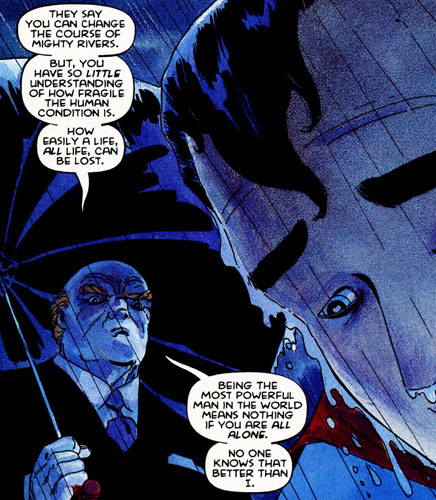
At the end, we see Clark heading back to Smallville, no longer sure if he can be Superman. It looks like Lex has gotten his revenge on the man who stole his city.
The final chapter is winter, narrated by Lana Lang. She tells the reader that she used to dream about marrying Clark, but as soon as he shared his secret with her, she knew that it would never happen. As she tells the story, we see images of Metropolis in winter. Luthor’s Guardians are now patrolling the skies, which the citizens don’t appreciate; Lois is wondering why Clark took a sudden leave of absence and where Superman could be. Lana’s recollection ends with her telling us that she knows that Clark is Superman, while Lois laughs at the possibility of the very same idea.
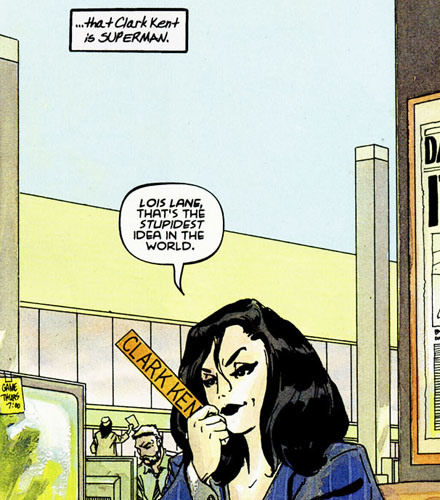
In Smallville, we find Clark and Lana, both home for a visit, getting ready to spend a day with Pete, who is still living in Smallville. They meet Pete in town, and are both surprised when Pete chides them for coming back after they’ve been out in the world.
Clark and Lana are still thinking about this later when they’re both back at the Kent farm, but are interrupted when the police chief shows up to tell them that the river is flooding. He recommends that they evacuate, but after the chief leaves, everyone agrees to stay on the farm and re-evaluate the situation in the morning. Clark reveals his worries to Pa, who tells him that he’ll figure things out in time.
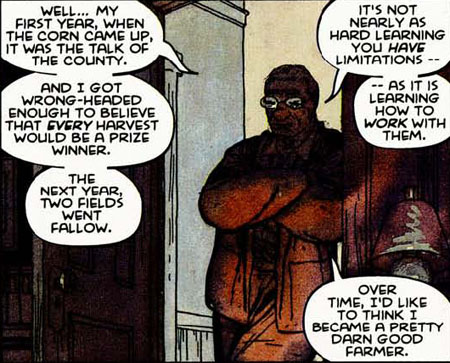
The morning sees Lana and the Kents packing up and getting ready to head to the evacuation site. Clark is in costume, preparing to go save those who are no longer able to get out on their own. Before she gets in the truck, Lana gives Clark some words of advice.
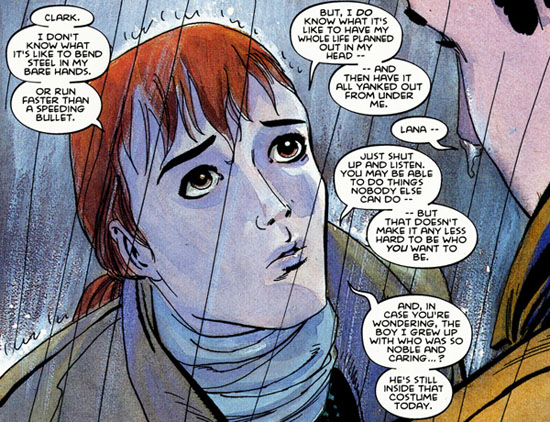
As the truck heads towards town, Clark flies off to help out where he can. He ends up having to save his parents and Lana when the truck falls into the river, but it turns out fine in the end; everyone makes it safely into town. Lana’s narration tells us about how Superman is a symbol for hope, something that inspires other people, and that it’s something that she carries with her.
Reinvigorated, Clark heads back to Metropolis, where he takes up his job at the Daily Planet and starts going out again as Superman. The Guardians are still patrolling, and when one tries to warn a child that he’s in danger of slipping off a snowy rooftop, it accidentally scares the boy into falling. He screams for help, and Superman flies in and saves him, telling the Guardian to inform Luthor that he’s back. We find out that this is the same kid that Superman helped out earlier in the story; he introduces himself as Trevor, “but everybody calls me ‘Trev’,” and we get this as the last page of the story:
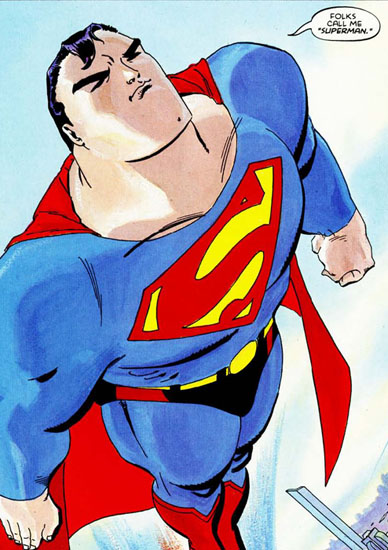
I like this origin story because it’s really different from the usual. Instead of the hero telling us about their beginnings, we get a variety of outside perspectives on what happened. From Pa Kent, we get a father just worried for his son; from Lois, we get the skeptic wondering why someone would want to help without getting anything in return. Luthor gives us the perspective of someone who thinks Superman is dangerous, and Lana brings the past and the present together, showing us how Clark has both grown since they were children.
We also get some little details that really ground the story in the Superman mythos. One of the background characters mentions that Martha’s maiden name was Clark, giving the reason for his name; in another scene, we actually see some people reacting to seeing Superman in the sky with “It’s a bird, it’s a plane!” It makes the entire origin feel more connected to Superman as a whole, and it’s fun to play “spot the Easter egg” while you’re reading.

In the end, this is just one Superman origin among several. It’s one that I like for how different it is from the normal approach, and I’ll be very interested to see what parts, if any, are used in Man of Steel, especially considering how many hints have been dropped that it draws from Birthright.
Superman For All Seasons. Written by Jeph Loeb; art by Tim Sale. Published 1998; collects Superman For All Seasons #1-4. Find it on Amazon or buy it from comixology.
Comments? Questions? Leave a reply! I’ll be happy to talk comics with you.

This is a Superman story that’s very often recommended – I’ve always wanted to check it out. I think it’s quite neat to have a story told by everyone except the person who’s ostensibly the star. That’s pretty awesome. With comics we are usually limited to hearing the protagonist’s inner monologue so it’s nice to see Loeb doing something different.
I think what’s almost more interesting is that the artwork is so different from the typical Superman artwork. In fact, the first thing I thought when I saw it in this article is that Superman looks kinda chubby. If you look at his “muscles” they even seem a bit doughy. It’s a pretty crazy comparison to the way Superman is drawn today (and has been drawn for a while now). There also seems to be a nice, bold use of color like the blues in the scene with Luthor holding the umbrella. Luthor also looks fatter than he’s usually depicted although, in this case it fits in better with the traditional American image of the fat cat industrialist.
It’s an interesting way to tell the story, and I like nontraditional ways of storytelling, so it really appealed to me. Overall, I think I prefer Birthright as an origin for Superman, but I like the style of this one a lot.
The art is really… well, to be honest, it’s my least favorite part of this story. I wondered at certain points in the story if Tim Sale had forgotten how to draw here. The landscape scenes are completely gorgeous… but sometimes Ma and Pa Kent look like piles of wrinkles instead of people. I’ve definitely loved Sale’s work in some other things, and I think that this was a definite stylistic choice – it does kind of evoke Norman Rockwell, which gives Smallville a definite homey feel to it. I’m just not sure it was completely effective.
I was discussing the story structure with a friend, who said that it would have been interesting if different artists had done each issue. Since we’re getting a different viewpoints from the writing, it would have been neat to see different literal views in the art, as well. At the very least, Sale could have altered his style a bit from issue to issue. I think it would have gone a lot further with showing that each part was from a different point of view.
That’s a good point. Although we railed a few weeks ago at comics that seem to change artists all the time, I think it can definitely be justified if each artist is supposed to be showing the mindset of another person. When I was around middle school age I read a science fiction story that influenced me so strongly that I still think of it today. It involved a machine that let you see the world through the eyes of another person. But, unlike Being John Malkovich, where you are literally seeing what they see, this was a device that showed you what their brains saw, if that makes sense. So if a person walking through grass imagines that they’re walking through a field in which each blade of grass was a snake, that’s what you’d see. Or if they were sad and saw the world as darker than it objectively was, that’s what you’d see. (For a similar effect in movies, see the scene in From Dusk Til Dawn when we see why Tarantino’s character keeps raping people. He’s nuts. He pictures the daughter telling him to do something to her and he doesn’t realize it isn’t real) So while you were mostly likely advocating a less radical stance, I think that would actually be a pretty great comic that I’d love to see. For example, what would a villain see as they walked through a busy street full of pedestrians?
I really would have liked to see this. Yeah, it sucks when artists change all the time – but when it’s done purposefully, with the intent to create different viewpoints, I think that would make a big difference.
It would definitely be an interesting idea for a book, to use different artists and different styles to show what certain characters were seeing.